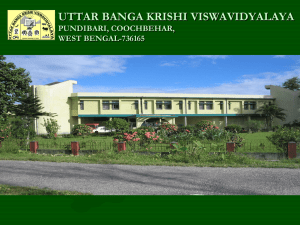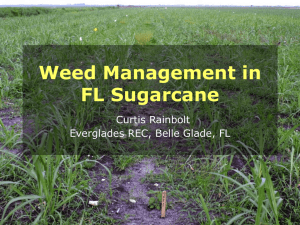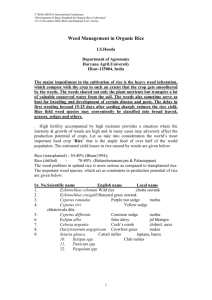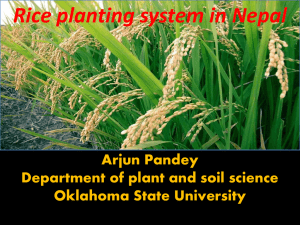Development of integrated weed management packages in rain fed
advertisement
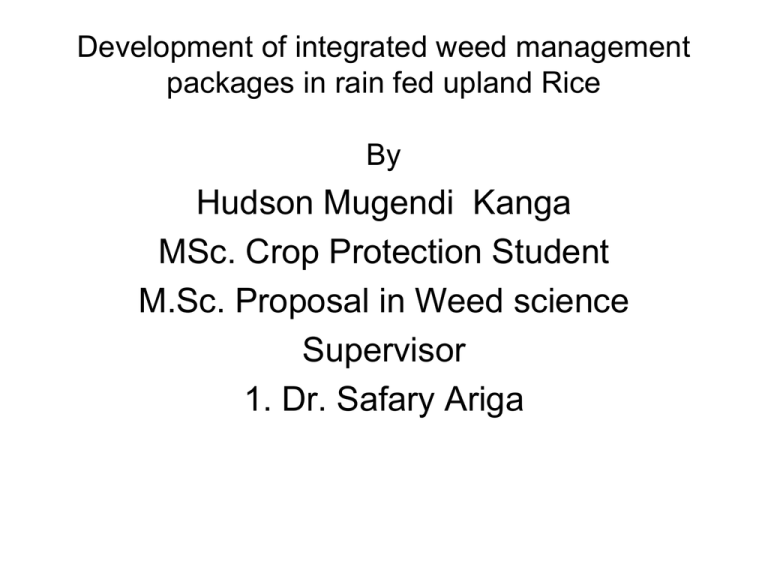
Development of integrated weed management packages in rain fed upland Rice By Hudson Mugendi Kanga MSc. Crop Protection Student M.Sc. Proposal in Weed science Supervisor 1. Dr. Safary Ariga Economic Importance • Rice (Oryza sativa L. or O. glaberrima) is the most important staple food crop worldwide • Globally, rice is the most favoured grain for direct human consumption as compared to maize and wheat, which are also used as livestock feed • In East Africa, rice is fast becoming an important food and cash crop with a per capita consumption range of 11 to 16 kg per person per year (USDA, 2010) • In Kenya, the crop introduced in 1907, is grown in all rice production ecologies. National rice consumption is estimated at 300,000 metric tons compared to an annual production range of 45,000 to 80,000 metric tons. • Rice consumption is increasing at a rate of 12% annually as compared to 4% for wheat and 1% for maize. Problem Statement. • Weeds can singly reduce grain yields of rice by 30 – 80% depending on cropping system and cultures. • It is notable that several methods of weed control may not singly and adequately smother weeds. For example hand weeding can be relatively ineffective, particularly in controlling many of the perennial weeds (e.g. Cyperus spp.) that have underground tubers and rhizomes from which they can rapidly re-establish. • Integrated management entails use of varied methods among them tolerant rice cultivars, cultural, herbicides and their combinations, biological, fallowing and hand weeding to sustainably control weeds of rice • One of the most constraining factors in rainfed upland rice production in Coast, Nyanza and Western provinces of Kenya is striga weed infestation. Striga weed. Justification • It is notable that several methods of weed control may not singly and adequately smother weeds. For example hand weeding can be relatively ineffective, particularly in controlling many of the perennial weeds (e.g. Cyperus spp.) • Various weed types associated with rice require; use of a combination of two or even five control methods that kill different types of weeds • One of the most constraining factors in rainfed upland rice production in Coast, Nyanza and Western provinces of Kenya is striga weed infestation • Several integrated techniques for of striga have been developed and tested. • • Several trials involving the use of FYM at 10 tons/Ha, Nitrogen at 50kgs/Ha and atphosphorous 50kgs/Ha have been conducted. Use of various combinations in this experiment will give superb results going by the individual methods researched in the past. Broad Objective 1)To determine, develop, validate and promote the most appropriate weed management technologies for weeds control in Upland Rice. Specific Objectives • To determine the best integrated weed control management package in Upland Rice. • To determine the most cost effective method of weed control in upland rice • To establish the most appropriate package of integrated weed management in the control of striga weed in upland rice General Methodology • 4 Rice varieties, Some striga resistant/tolerant and the other ones less tolerant were selected as part of the integrated weed management package in the combination of treatments .The varieties must be the common ones used by farmers in western Kenya(Kaewchumnong and Price (2000).Also Furthmore,Johnson et al. • The land where the rice will be grown will be plowed by tractors. • In experimental plots where the Farm yard manure will be applied, it will involve incorporation before the actual date of planting.At 10 t/Ha • The nitrogen component as part of the treatment combination will be applied above the normal rates common for all the treatments.(Mumera 1983) 39 kgN/Ha General Methodology contn. • The control plots will be the normal farmers practice of 2 weeding per crop and another one without weeds connntrol. The crop fertilizer application schedule will follow the normal recommendations in the region. • Herbicides application in the treatments and experimental plots will be as per the researchers recommendation. • Some experimental plots will have cow pea intercropped in between. This is in an effort to integrate more on striga weed management which is prevalent prevalent in the area. It will be planted at the same time with Rice. Achievement of Objectives To determine the best integrated weed control management package in Upland Rice • From the various packages in the treatments, objective one will be achieved after the analysis of the results. • Objective 2 will too be known after the results when the gross margins for various experimental units are computed. • Objective 3 will likewise be met as all the combinations of treatments in this experiment fully address this objective. Treatments 1. 2 hand weedings (Farmers practice) 2.No weeding-Control 3. Farm yard manure + Nitrogen fertilizer+ Pre- emergence herbicide+1 weeding 4. Farm yard manure + Nitrogen fertilizer+ pre-e herbicide+1post-e herbicide 5. Farm yard manure + Nitrogen fertilizer+ 2 Hand weeding 6. Farm yard manure+ Nitrogen Fertilizer + cow pea+ 2 Hand weeding There will be one variety for each of the above treatments. i.e NERICA 1, 4, 10 and Dourado precoce making a total of 24 treatments. As mentioned earlier this is part of incorporating resistance as an aspect in striga weed control. These treatments will be replicated 3 times. Methodology contn • The project will be conducted in Busia county either at KARI Alupe or Busia ATC. • The design will be Randomized complete Block Design-RCBD. • The data collection method will be random, by taking a transect walk in the plots and pegging the selected plants or area for data collection. • The parameters or data collected will be , Yields, Plant height, Leaf length and width, Shoot/root ratio, Weed count, Pests and disease incidences, crop vigor and assessment of crop quality. Data Analysis • Data analysis will be by ANOVA. Materials • Rice Seeds and Cow pea seeds • Fertilizers-SSP and CAN or NPK and CAN • Farm Yard Manure • Pre and Post emergence Herbicides Equipment • Knap sack Sprayer • Wheel Barrow • Spade • Digging Hoe • Planting Line • Tape Measure Expected Results • The treatments combinations described above will give high yields especially in plots where striga weed will be controlled. • An efficient, cost-effective weed control package will be realized after data collection and analysis and generalization. • An integrated weed control strategy that manages striga weed in rain fed upland rice will be realized Item 2013 Jan-April Proposal and presentation ********** ********** *********** First season Crop Second season crop Data analysis and presentation Thesis and submitting Y E A R 2013 AprilMay 2013 AugustDec 2014 Jan-Dec 2014 Jan-June. ******** ********* ********* ******** ******** ******** ******* ******** ********* ********* ********** Budget T ITEM DESCRIPTION GFS CODE QUANTITY UNIT COST TOTAL 1 2 3 4 Seeds Cow peas Fertilizer Farm yard manure 2211007 2211007 2211007 2211007 30 4 kgs 100 kgs 2 pick ups 100 400 84 1500 3,000 1,600 8,400 3,000 5 Herbicides 2211007 4 litres 1500 6,000 6 7 8 Weeding Labor Plowing and Harrowing Planting labor 2110202 2110202 20 4 34 250 2750 250 5,000 11,000 8500 9 Harvesting Labor 2110202 30 250 7,500 10 Supervisors fuel 2211201 30 1,000 30,000 11 Researcher’s fuel 2211201 20 1,000 20,000 12 Supervisors Vehicle maintenance 2220101 2 80,000 160,000 13 Researcher’s Vehicle maintenance 2220101 1 80,000 80,000 14 Researcher’s subsistence 2210303 10 10,000 100,000 15 Supervisors subsistence 2210303 10 10,000 100,000 Total 544,000

